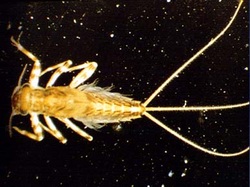|
Great news! Graduate student Natalie Stauffer has been awarded several fellowships in the past two weeks. She received a Resh Award for her research and an O&E summer student fellowship that will pay stipend for summer 2015. She was also just selected for a Berkeley Connect position for the 2015-2016 academic year. Excellent work Natalie!
1 Comment
Natalie passed her oral exams today! From what I've heard, she did a wonderful job. Be sure to congratulate her next time you see her in the lab.
Review: Webb et al. (2011) DNA Barcoding of North American Ephemeroptera: Progress and Prospects10/12/2012  This paper was a convincing argument for the promise of DNA barcoding taking over the world, basically. DNA barcoding of aquatic macroinvertebrates is gaining backing as an extremely useful tool for taxonomic identification and research, and in turn, application in bioassessment programs. Some have argued that DNA barcoding is an unreliable way to identify aquatic macroinvertebrates, but this paper shoots those ideas down; (!!!) as it found that the average intraspecific divergence was 12.5%, while the average intraspecific divergence was 1.97%. While there were some complications in identification, caused mainly by polyphyly and species complexes (which still need to be further studied and resolved,) in general these results indicate that DNA barcoding is, in general, a promising tool in aquatic macroinvertebrate taxonomy and bioassessment programs. Aside from the intra and interspecific divergences being accurate, for the most part, this paper further points out that DNA barcoding is particularly useful for other reasons. In addition to helping streamline the identification, delimitation, and discovery of species, DNA barcoding also gives consistent results across life stages, which is particularly important in aquatic ecology applications, as a large majority of benthic macroinvertebrates are immature. In many cases, taxonomy is based on adult male morphology, and identification of immatures, particularly early instars, is exceedingly time-consuming and requires substantial training. Additionally, specimens are often very tiny, and delicate, which can lead, in many cases, to missing gills, caudal filaments or even legs, which can in turn further complicate accurate identifications. Furthermore, the use of DNA barcoding allows for data standardization, and thus a broader, more accurate comparison of results. This paper also suggested that much more work on North American Ephemeroptera taxonomy and classification is required, as many currently recognized species are highly divergent. Most of these confused species have complex histories of synonymy and reflect the 60 year trend in North American mayfly systematics towards inclusive species concepts. Further taxonomic work that synthesizes a variety of identification and classification methods including morphological, biogeographic, ecological, behavioral and molecular techniques is required to test current species hypotheses, particularly of those unusually divergent Ephemeroptera species. DNA barcoding is one of the techniques that will be useful in this aim of achieving stable, supported species hypotheses. Re-examined and updated species hypotheses will allow us to identify aquatic insects more accurately and more efficiently, which will in turn allow us to determine and communicate the ecological characteristics of a species, such as phenology and tolerance to pollutants, and thus improve our ability to utilize these organisms in bioassessment programs. Natalie Stauffer This article looks at the changes in endophyte communities in leaves of a single species of tree in different environments on Mauna Loa Volcano, Hawai’i. According to this article, the phyllosphere, or the surface and interior of leaves, is one of the least studied environments in the world (even though its area is approximately twice that of land surface!). The phyllosphere also happens to host an incredibly high number of fungal endophytes, as discovered by this study. Specifically, this study looked at operational taxonomic units (OTU’s), and determined that there were over 4,200 OTU’s present at the 13 study sites, all of which were found on the same species of tree, and within 80 km of each other. This richness in OTU’s represents roughly half of the number of OTU's found in a global study of indoor fungi-which is a huge amount of diversity! And all of this diversity was found on a single host species. Clearly, there is potential for a much higher level of fungal diversity than previously thought.
Aside from finding a huge amount of fungal diversity, this study also found that environmental variables are a factor in determining the fungal endophyte community of the phyllosphere. The environmental variables that were looked at were rainfall, elevation, and the age of the lava that the site/tree was located on. The study found that fungal endophytic communities were more similar with similar amounts of rainfall and elevation; thus communities correlated with these environmental variables. This finding is important for a number of different applications, including carbon fixation, community ecology, and climate change. Finding out more about how differences in temperature and rainfall will change the phyllosphere and how it functions could help us predict and understand yet another possible effect of climate change. Additionally, looking at the roles of these many different species of fungi in the phyllosphere community could help us design more effective solar sequestration methods. If I wasn’t already betrothed to a PhD project looking at barcoding of benthic macroinvertebrates and biomonitoring of aquatic ecosystems, I would definitely be interested in looking at the fungal endophytic communities within the phyllosphere! Natalie Stauffer NB Zimmerman and PM Vitousek (2012). Fungal endophyte communities reflect environmental structuring across a Hawaiian landscape |
PatrickProfessor Archives
April 2018
Categories
All
|
| O'Grady Lab |
|
 RSS Feed
RSS Feed
